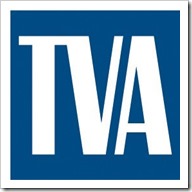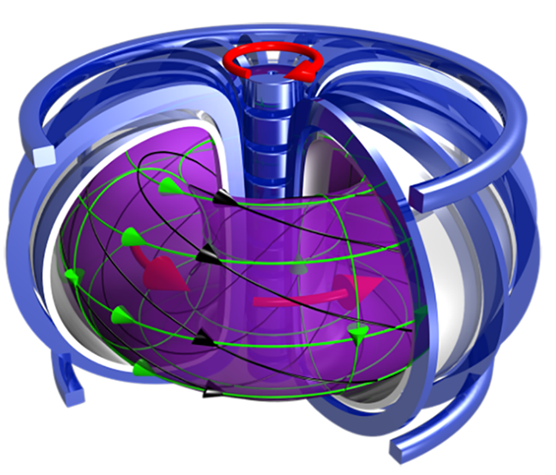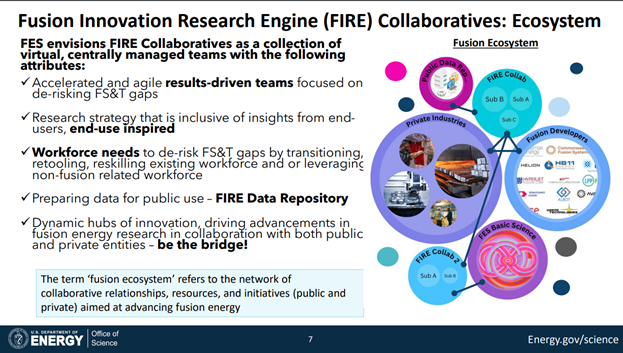- Type One Energy to Build a Fusion Prototype at TVA’s Bull Run Site
- Q&A with Type One Energy (Neutron Byes exclusive)
- Type One Energy to Support Five of the Six Projects Selected for DOE’s FIRE Funding
- What is a Stellarator?
Type One Energy Group announced the company’s plans to locate to the Tennessee Valley Authority’s (TVA) Bull Run site in Clinton, TN, to build Infinity One, the company’s stellarator fusion prototype machine. The construction of Infinity One could begin in 2025, following the completion of necessary environmental reviews, partnership agreements, required permits, and operating licenses.
Conceptual Image of a Stellarator: Image: IAEA
Project Infinity is the result of a tri-party memorandum of understanding signed in 2023 between TVA, Type One Energy, and the U.S. Department of Energy’s Oak Ridge National Laboratory (ORNL). The partnership is based an interest in the development and commercialization of economic and practical fusion energy technologies.
Project Infinity is the first recipient of funds from Tennessee Governor Bill Lee’s Governor’s Nuclear Energy Fund. He believes that the construction of Infinity One at Bull Run coal fired power plant aligns with the state’s vision to position the state as a national leader in clean energy.
 In partnership with TVA and ORNL, Type One Energy will explore subsequent opportunities to further advance commercial deployment of fusion energy in the East Tennessee region.
In partnership with TVA and ORNL, Type One Energy will explore subsequent opportunities to further advance commercial deployment of fusion energy in the East Tennessee region.
Infinity One will allow Type One Energy to verify important design features of its high field stellarator fusion pilot plant, particularly those related to operating efficiency, reliability, maintainability, and affordability.
Type One Energy will establish its headquarters in East Tennessee. The firm expects the facility to create over 300 jobs within the next five years. Project Infinity, which includes the deployment of Infinity One and Type One Energy’s new headquarters, is expected to bolster economic growth and energy technological leadership in the region.
Type One Energy CEO Christofer Mowry said “Successful deployment of Infinity One in East Tennessee, with our partners TVA and ORNL, is a critical milestone in our FusionDirect commercialization program.”
“It is also a watershed moment toward the commercialization of fusion, linking for the first time leaders in the technology, utility, and national laboratory sectors on an actual deployment project.”
Mowry is no stranger to TVA nor to East Tennessee. He previously was the CEO of a firm that was at one time involved in a joint development and licensing effort with TVA for a 180 MW small modular reactor using a light water reactor design.
More significantly, he was the CEO of General Fusion from 2017-2022 which gives him the management equivalent of being a two-for-one presence on Type One’s Project Infinity effort with TVA in ORNL’s backyard.
TVA President and CEO Jeff Lyash said, “TVA is working with our partners to pursue new ideas and innovative solutions that meet growing energy demand in real-world conditions.”
Oak Ridge National Laboratory Director Stephen Streiffer said, “The laboratory has been a pioneer in fusion science and technology dating back to the early 1950s. We look forward to applying our institutional expertise and capabilities in working with Type One Energy on the engineering challenges they will be tackling at this new test facility.”
What is Project Infinity?
In February 2024, Type One Energy announced Project Infinity and the selection of a former Bull Run Fossil Plant in Clinton, TN, as the building site for its first in-situ stellarator testbed, Infinity One.
Infinity One will verify important aspects of a fusion pilot plant design and operating efficiency, reliability, maintainability, and affordability. This first-of-a-kind industry cooperation agreement to demonstrate fusion power plant technology readiness.
The primary goals of the Project Infinity program and Infinity One include:
- Demonstrating the efficacy of our modular high-temperature superconducting (HTS) magnet system for stellarators,
- Evaluating stellarator plasma performance in the presence of a metallic first wall,
- Verifying the reduction in plasma heat loss from turbulence, and
- Confirming improved exhaust efficiency.
Infinity One will also provide a testbed for demonstrating improved manufacturing, construction, and commissioning processes, both in cost and time, using design innovations and modern methods.
High-Performance Computing Optimizes Our Designs
Because confinement of the plasma in a stellarator is driven solely by the external magnets, modifying the shape and strength of the fields has a major impact on performance. To tailor a three-dimensional magnetic field with the right shape to achieve quasi-symmetry requires extensive calculations. Advances in computer modeling code and high performance computing has provided this ability.
What is a Stellarator?
The U.S. Department of Energy defines a Stellarator fusion system as follows.
“The stellarator is one of the technologies scientists believe could lead to real-world fusion power. A stellarator is a machine that uses magnetic fields to confine plasma in the shape of a donut, called a torus. These magnetic fields allow scientists to control the plasma particles and create the right conditions for fusion. Stellarators use extremely strong electromagnets to generate twisting magnetic fields that wrap the long way around the donut shape.
Stellarators have several advantages over tokamaks, the other main technology that scientists are exploring for fusion power. Stellarators require less injected power to sustain the plasma, have greater design flexibility, and allow for simplification of some aspects of plasma control. However, these benefits come at the cost of increased complexity, especially for the magnetic field coils.
To advance stellarator design, scientists have turned to high performance computing and state-of-the-art plasma theory. These tools have helped researchers optimize the Helically Symmetric Experiment (HSX) stellarator in Wisconsin and the Wendelstein 7-X stellarator in Germany.”
Q&A with Type One Energy
Note to Readers: Type One Energy responded via email to written questions about Project Infinity and the firm’s agreement with the Tennessee Valley Authority (TVA). The firm’s answers to these questions are included below.
Q: What factors, features, value, etc., convinced TVA to take a partnership with a fusion company, and why, among all the available choices for fusion startups in the US, did it choose Type One?
A: Type One is developing a stellarator. Stellarators have a strong business case with many characteristics when compared to other fusion technologies that are desirable for commercial power plants. Stellarators operate in a steady state, are inherently safe, and have no long-term radioactive waste. Related to tokamaks, stellarators do not require massive circulating electric currents to assist in creating the magnetic fields used to confine their fusion plasma. This makes stellarator technology less physically complex and easier to translate into a practical fusion power plant. These attributes make Type One’s stellarator ideal for baseload power plant operations. Type One is designing a commercial pilot power plant called Infinity Two based on technology already developed, built and operated in the U.S. (HSX)., and a large-scale demonstration in Germany (W7-X).
Q: What are the key advantages for Type One emerging from the partnership with TVA that enables it to be a first mover in the fusion field that it would not have if it did not have the partnership?
A: TVA’s expertise in power plant operations, maintenance, engineering, licensing, and construction allows Type One Energy to focus solely on developing stellarator fusion technology, reducing commercialization risks. Type One Energy will be able to maximize the know-how and physical assets TVA’s Power Service Shops (PSS) in Alabama for modular manufacturing and assembly. As a result, this agreement puts us in the position to shape the stellarator fusion power plant supply chain. The agreement also includes a commitment to workforce development, ensuring local talent is trained in assembling, operating, and maintaining fusion power plants.
Q: What’s in it for both parties? For instance, will TVA become an investor in Type One, if so for how much in cash, and if not, what does TVA really bring to the table that further enables Type One to speed up time to market?
A: TVA is not investing in, or receiving any equity in Type One. We have announced a Cooperative Agreement that expands on Project Infinity, first launched by Type One Energy, TVA, and the U.S. DOE’s Oak Ridge National Laboratory (ORNL) in early 2024, with support from the state of Tennessee. Originally, our work together centered on deploying the Type One Energy Infinity One stellarator prototype in TVA’s Bull Run power plant. Now, Project Infinity encompasses a deeper, broader engagement toward the commercialization of fusion energy.
Type One Energy’s strategy is to avoid the time, cost, and risks associated with trying to learn how to build, own, operate, and maintain power plants. Other companies already do those things, things which are very hard to do well. TVA’s expertise in power plant operations, maintenance, engineering, licensing, and construction allows Type One Energy to focus solely on developing stellarator fusion technology, reducing commercialization risks. For TVA, engaging with Type One Energy will increasingly involve the communities of the Tennessee Valley in Project Infinity to benefit from the investment, jobs, and energy security that fusion energy offers.
Q: Is any funding for this deal coming from the federal government?
A: No federal funding is being used to build Infinity One. Type One was the first recipient of the Tennessee Nuclear Investment Fund and some of those funds will be invested in the Infinity One project.
Q: Where is Type One in its investor rounds, e.g., Series A, B or C?
A: We closed the largest seed round in the fusion sector in 2024 of $82.4 million.
Q: Who are its major investors who have been previously publicly identified in Crunchbase, Pitchbook, etc., and how much cumulatively has the firm raised to date from investors. How much more cash will it need to commercialize its design?
A: We are fortunate to be able to speak to many excellent investors interested in fusion today including SeaX Ventures and TDK.
Breakthrough Energy Ventures (BEV), TDK Ventures and Doral Energy Tech Ventures co-led our Seed round with additional cleantech investment from Darco, the Grantham Foundation, MILFAM, Orbia Ventures, Shorewind Capital, TRIREC, VAHOCA and others.
Q: Are there key milestones or performance measures that are part of the partnership and if so what are they and when are they due?
A: The agreement outlines activities that will be collaboratively developed. We envision a series of milestones with commitments to be further defined in subsequent amendments and agreements. Collaboration activities may focus on areas such as assessing and supporting the development of information to meet regulatory requirements, exploring financing vehicles and structures for funding Project Infinity activities, preliminary design of Infinity Two–including cost estimates, site evaluations.
Q: Diving in deeper, what is it about Type One’s technology, maturity of its product on the path to commercial launch, and overall business case that brought TVA to the table?
A: Type One has built an organization with people who understand our end customers, an organization built to complement our end customers’ capabilities. We now have an organization with deep experience in designing and building stellarator fusion machines, in supporting the construction operation and maintenance of power plants as an OEM and as a technical services provider, and in understanding the intricacies of the global energy markets. This makes Type One unique.
TVA and Type One Energy will collaborate on Infinity Two fusion power plant siting studies, environmental reviews, and licensing, as well as development of project plans and financing from various sources. Type One Energy will support TVA in its evaluation and review of the fusion project.
Q: It is well known that TVA has a partnership with GE Hitachi for development of a small modular fission reactor at Clinch River. Is this partnership modeled after that deal or is it unique? In what ways is the partnership a first of a kind for a major utility, especially TVA?
A: We envision this project will follow a similar path in the same respect of working with TVA to understand where our technology is in development and what needs to happen over the next few years to alleviate enough risk to deploy a Type One Stellarator Fusion Power Plant in their service area. This agreement is the first step in defining the roadmap to get the project heading down the path to an eventual decision on whether or not to deploy a plant. It is unique since fission and fusion are very different and the same challenges that exist for fission do not apply to fusion. TVA is the first major utility agreeing to work with a stellarator fusion company, to develop a roadmap to a potential deployment of a fusion power plant.
Q: What support is being provided by the State of Tennessee? Given Type One’s work with ORNL, is the lab an active partner in this deal or providing in kind or contracted support to it?
A: Last year, Tennessee Gov. Bill Lee and the Department of Economic and Community Development Commissioner Stuart C. McWhorter announced the state’s investment into Type One Energy through the newly created Nuclear Energy Fund. Established by Executive Order 101, the fund was created to support Tennessee’s nuclear development and manufacturing ecosystem by providing assistance to nuclear power-related businesses choosing to relocate or grow in the state. Type One Energy will create a total of 330 new jobs by establishing its headquarters in the Greater Knoxville region and expanding fusion research and development (R&D) operations in Clinton.
ORNL is not a party to this agreement, although we are working with ONRL on other activities related to Project Infinity which we plan to discuss publicly in the future.
Q: Assuming the Type One fusion reactor reaches the milestone of having a licensed commercial version, and successfully builds and commissions a first of a kind unit, will TVA buy it or will TVA ink a power purchase agreement with Type One.
A: Type One is an organization with deep experience in designing and building stellarator fusion machines, in supporting the construction operation and maintenance of power plants as an OEM and as a technical services provider. We do not envision owning or operating power plants and feel that is the value in working with a utility that has a history of operating power plants for a living, and has a reputation for being best-in class in doing these challenging things.
Q: Who will operate the fusion reactor – TVA or Type One? Is this a build and operate deal for Type One or is there a non-binding power purchase agreement part of the partnership? If so, what are its terms for power to be provided, etc.
A: This is a cooperative agreement to position TVA’s talent and resources in the states of Tennessee and Alabama to participate in the growing fusion sector. We find great value in working with a utility that has a history of operating power plants for a living, and has a reputation for being best-in class in doing these challenging things.
We expect the assessments and demonstrations underway in Project Infinity will facilitate future commitments to build commercial Type One fusion power plants with many utilities. We do not envision owning or operating power plants.
Q: How many fusion reactors will Type One build for TVA?
A: This agreement does not commit TVA to build any Type One Plant but begins to develop a roadmap on how stellarators can be deployed commercially
Q: What site, if any, has TVA chosen for the Type One fusion reactor(s). Will the fusion reactor need a new grid connection at the chosen site or will it leverage the switchyard at a current site? Is Bellefonte one of the sites under consideration? Site selection will come later.
At this stage, we are focused on completing the design of Infinity Two and testing it with the Infinity One prototype in TVA’s Bull Run plant. Fusion plants should be able to utilize various systems at existing power plants, including coal, gas, or fission, such as switch-yard, water, road and railways. The ability for us to focus on developing and delivering the core stellarator technology materially de-risks our path to fusion power plant commercialization.
& & &
Type One Energy to Support Five of the Six Projects Selected for FIRE Funding
Type One Energy is one of five of the six projects selected for funding in the U.S. Department of Energy’s (DOE) new Fusion Innovative Research Engine (FIRE) Collaboratives program. The goal of FIRE is to accelerate the development of fusion energy by fostering collaboration between basic science research and the rapidly advancing fusion industry, including activities supported under the Milestone Program, of which Type One is a participant.
In its role as an industry advisor to the awardees, Type One will work closely with top research teams and other industry experts to bridge the gap between fundamental scientific advancements and real-world fusion energy applications. The projects selected for funding cover a wide range of fusion S&T areas, including simulation, advanced materials, blanket design, and fuel-cycle systems.
Type One looks forward to working with the teams at Massachusetts Institute of Technology, Savannah River National Laboratory, Idaho National Laboratory, Oak Ridge National Laboratory, and University of Tennessee, Knoxville.
# # #













